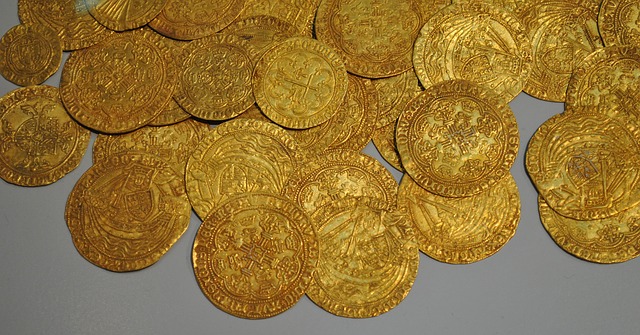By Tim Lambert
Early Coins
At first, people simply bartered, that is they exchanged goods for goods. However, eventually, it became convenient to have one thing that could be exchanged for any goods. Before the Celts used coins, they used iron bars as a form of currency. The Chinese used cowrie shells.
However, finally, people invented coins made of precious metals. The value of the coin depended on the amount of metal it contained.
It is believed the first coins were made in Lydia, which is now part of Turkey, before 600 BC. In the 5th century BC, Greek city-states took up the idea and began making silver coins. At roughly the same time, the Chinese began making coins.
The Romans first began making coins in the 3rd century BC. The Romans used a gold coin called an aureus and a silver coin called a denarius. Low-denomination coins included the sestertius, the dupondius, and the semis, which were made of orichalcum, an alloy of copper and zinc. The as and the quadrans were made of copper.
Meanwhile, in England, the Celts had learned to make their own coins.
In the 4th century, a new Roman gold coin called the solidus was introduced.
English Coins
From the 8th century, the Anglo-Saxons made silver pennies. A pound of silver was melted to make 240 pennies. There were 240 pennies in a pound until 1971. However, in the 8th century, a penny was a large sum of money (4 or 5 pence would buy a sheep). Most people continued to barter for everyday goods.
In the late 13th century, the farthing (one-quarter of a penny) was introduced. (The farthing ceased to be legal tender in 1961). Also in the late 13th century, halfpennies and groats (worth fourpence) were minted.
In the 14th century, a coin called a noble, which was worth 80 pence or 1/3 of a pound, was minted. So, were coins called half-nobles. However, they went out of use about 1470, and they were replaced by coins called angels and half-angels. Angels were last used in the early 17th century.
In the early 16th century, silver was discovered near the city of Joachimsthal in what is now the Czech Republic. Silver coins were made, which were called Joachimsthalers. Later, they were called thalers, and our word dollar is derived from that.
Meanwhile, in the 16th century, the word ‘cash’ was used in England. It is derived from the French word ‘casse’ or the Italian word ‘cassa’. Both meant a little box, but by the time the word reached England, it had come to mean the money kept in the box.
Shillings were first minted during the reign of Henry VII. There were 12 pence in a shilling. Henry VII also introduced a coin called the sovereign, which was worth 20 shillings. The sovereign was last minted in the early 17th century.
His son, Henry VIII, introduced the crown, worth 5 shillings, and the half-crown, worth 2 shillings and sixpence.
The first sixpence coin was minted in 1551. So was the first threepence coin.
The Chinese invented paper money. It was first used in Europe in the 17th century. The Bank of England was founded in 1694. From the start, the bank used the pound sterling as a monetary unit. The bank issued notes for so many pounds sterling (worth one pound of sterling silver). (Our pound sign is derived from an ‘L’, which stood for libra, a Latin measurement of weight with crossbars to show it was an abbreviation). At first, notes were handwritten, and they were made out to a named person or ‘the bearer’. Notes could be exchanged for cash at the bank.
Also in the 17th century, coins were milled, that is, they were made with serrated edges to prevent people from removing precious metals.
In 1663, a new coin called the guinea was introduced. It got its name because it used gold from Africa. In 1717, its value was fixed at 21 shillings.
In the 18th century, an engraver called John Sigismund Tanner designed a sixpence coin, and so it was nicknamed a ‘tanner’.
The gold florin was first made in Florence in 1252. However, in England, a florin was a 2-shilling coin. Florins were first minted in England in 1849.
With decimalization in 1971, a pound became worth 100 pence. Old coins like the sixpence and the threepence disappeared. New coins like the 50 pence and the 10 pence appeared.
Before decimalisation, the abbreviation for pence was d from the Latin word denarius. In 1971, it was changed to ‘p’. Meanwhile, the UK gained its first credit card in 1966. Pound coins were introduced in 1983. Pound notes ceased to be legal in 1988.

In Britain, the first credit card, Barclaycard was introduced in 1966. The first debit card was introduced in 1987. Contactless payment was introduced in 2007.
Last revised 2025